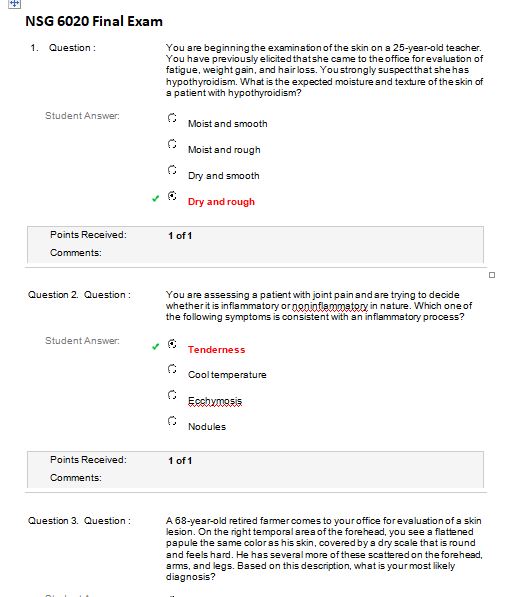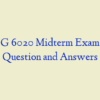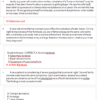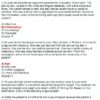Description
NSG 6020 Final Exam – Question with Answers – South University
- You are beginning the examination of the skin on a 25-year-old teacher. You have previously elicited that she came to the office for evaluation of fatigue, weight gain, and hair loss. You-strongly suspect that she has hypothyroidism. What is the expected moisture and texture of the skin of a patient with hypothyroidism?
- You are assessing a patient with joint pain and are trying to decide whether it is inflammatory or noninflammatory in nature. Which one of the following symptoms is consistent with an inflammatory process?
- A 68-year-old retired farmer comes to your office for evaluation of a skin lesion. On the right temporal area of the forehead, you see a flattened papule the same color as his skin, covered by a dry scale that is round and feels hard. He has several more of these scattered on the forehead, arms, and legs. Based on this description, what is your most likely diagnosis?
- A 28-year-old graduate student comes to your clinic for evaluation of pain “all over.” With further questioning, she is able to relate that the pain is worse in the neck, shoulders, hands, low back, and knees. She denies swelling in her joints. She states that the pain is worse in the morning……..
- Heberden’s nodes are commonly found in which one of the following diseases?
- A new patient is complaining of severe pruritus that is worse at night. Several family members also have the same symptoms. Upon examination, areas of excoriated papules are noted on some of the interdigital webs of both hands and on the axillae. This finding is most consistent with nsg 6020 final exam
- An obese 55-year-old woman went through menarche at age 16 and menopause 2 years ago. She is concerned because an aunt had severe osteoporosis. Which one of the following is a risk factor for osteoporosis?
- Ms. Whiting is a 68-year-old female who comes in for her usual follow-up visit. You notice a few flat red and purple lesions, about 6 centimeters in diameter, on the ulnar aspect of her forearms but nowhere else. She doesn’t mention them. They are tender when you examine them. What should you do?
- A 58-year-old man comes to your office complaining of bilateral back pain that now awakens him at night. This has been steadily increasing for the past 2 months. Which one of the following is the most reassuring in this patient with back pain?
- The Phalen’s test is used to evaluate:
- Which of the following would lead you to suspect a hydrocele versus other causes of scrotal swelling?
- You are examining a newborn and note that the right testicle is not in the scrotum. What should you do next?
- A 50-year-old truck driver comes to your clinic for a work physical. He has had no upper respiratory, cardiac, pulmonary, gastrointestinal, urinary, or musculoskeletal system complaints. His past medical history is significant for mild arthritis and prior knee surgery in college. He is married and just changed jobs, working for a different trucking company……A 15-year-old high school football player is brought to your office by his mother. He is complaining of severe testicular pain since exactly 8:00 this morning. He denies any sexual activity and states that he hurts so bad he can’t even urinate. He-is nauseated and is throwing up. He denies any recent illness or fever. His past medical history is unremarkable. He denies any tobacco, alcohol, or drug use. His parents are both in good health. On examination, you see a young teenager lying on the bed with an emesis basin. He is very uncomfortable and keeps shifting his position. His blood pressure is 150/100, his pulse is 110, and his respirations are
- On visualization of the penis, he is ….and there are no lesions and no discharge from the meatus. His scrotal skin is tense and red. Palpation of the left testicle causes severe pain and the patient begins to cry. His prostate examination is unremarkable. His cremasteric reflex is absent on the left but is normal on the right. By catheter you get a urine sample and the analysis is unremarkable. You send the boy with his mother to the emergency room for further workup.
- Which is true of prostate cancer?
- Which of the following conditions involves a tight prepuce which, once retracted, cannot be returned?
- A 12-year-old is ….to your clinic by his father. He was taught in his health class at school to do monthly testicular self-examinations. Yesterday, when he felt his left testicle, it was enlarged and tender. He isn’t sure if he has had burning with urination and he says he has never had sexual intercourse. He has had a sore throat, cough, and runny nose for the last three days. His past medical history is significant for a tonsillectomy as a small child. His father has high blood pressure and his mother is healthy. On examination, you see a child in no acute distress. His temperature is 100.8 and his blood pressure and pulse are unremarkable…….
- The most common cause of cancer deaths in males is nsg 6020 final exam
- Important techniques in performing the rectal examination include which of the following?
- Jim is a 47-year-old man who is having difficulties with sexual function. He is recently ….from his wife of 20 years. He notes that he has early morning erections but otherwise cannot function. Which of the following is a likely cause for his problem?
- Which of the following is the most effective pattern of palpation for breast cancer?
- A 14-year-old junior high school student is brought in by his mother and father because he seems to be developing breasts. The mother is upset because she read on the Internet that smoking marijuana leads to breast enlargement in males. The young man adamantly denies using any tobacco, alcohol, or drugs. He has recently noticed changes in his penis, testicles, and pubic hair pattern……..
- Which of the following represents metrorrhagia?
- What does a KOH (potassium hydroxide) prep help the nurse practitioner diagnose?
- Which of the following is true of human papilloma virus (HPV) infection?
- Abby is a newly married woman who is unable to have intercourse because of vaginismus. Which of the following is true?
- A 30-year-old man notices a firm, 2-cm mass under his areola. He has no other symptoms and no diagnosis of breast cancer in his first-degree relatives. What is the most likely diagnosis?
- Which of the following is true regarding breast self-examination?
- A 23-year-old computer programmer comes to your office for an annual examination. She has recently become sexually active and wants to be placed on birth control. Her only complaint is that the skin in her armpits has become darker. She states it looks like dirt, and she scrubs her skin nightly with soap and water but the color stays. Her past medical symptoms consist of acne and mild obesity…… nsg 6020 final exam
- What disorder of the breast or axilla is she most likely to have?
- Which of the following is true of women who have had a unilateral mastectomy?
- A 76-year-old retired farmer comes to your office complaining of abdominal pain, constipation, and a low-grade fever for about three days. He denies any nausea, vomiting, or diarrhea. The only unusual thing he remembers eating is two bags of popcorn at the movies with his grandson, three days before his symptoms began……
- What diagnosis for abdominal pain best describes his symptoms and signs?
- Jim is a 60-year-old man who presents with vomiting. He denies seeing any blood with emesis, which has been occurring for two days. He does note a dark, granular substance resembling the coffee left in the filter after brewing. What do you suspect?
- A 26-year-old sports store manager comes to your clinic, complaining of severe right-sided abdominal pain for twelve hours. He began having a stomachache yesterday, with a decreased appetite, but today the pain seems to be just on the lower right side. He has had some nausea and vomiting but no constipation or diarrhea. His last bowel movement was the night before and was normal. He has had no fever or chills. He denies any recent illnesses or injuries. His past medical history is unremarkable. He is engaged. He denies any tobacco or drug use and drinks four to six beers per week. His mother has breast cancer and his father has coronary artery disease.
- What is the most likely cause of his pain?
- Josh is a 14-year-old boy who presents with a sore throat. On examination, you notice dullness in the last intercostal space in the anterior axillary line on his left side with a deep breath. What does this indicate?
- Diminished radial pulses may be seen in patients with which of the following?
- A 42-year-old florist comes to your office, complaining of chronic constipation for the last six months. She has had no nausea, vomiting, or diarrhea, and no abdominal pain or cramping. She denies any recent illnesses or injuries. She-denies any changes to her diet or exercise program. She is on no new medications. During the review of systems (ROS), you note that she has felt fatigued, had some weight gain, has irregular periods, and has cold intolerance. Her past medical history is significant for one vaginal delivery and two cesarean sections…….
- What is the best choice for the cause of her constipation?
- A 57-year-old maintenance worker comes to your office for evaluation of pain in his legs. He has smoked two packs per day since the age of sixteen, but is otherwise healthy. You are concerned that he may have peripheral vascular disease. Which of the following is part of common or concerning symptoms for the peripheral vascular system?
- You are assessing a 59-year-old gas station owner for atherosclerosis in the lower extremities. In which of the following locations would the patient’s pain make you concerned for this disease process?
- A 55-year-old secretary with a recent history of breast cancer, for which she underwent surgery and radiation therapy, and a history of hypertension comes to your office for a routine checkup. Which of the following aspects of the physical are important to note when assessing the patient for peripheral vascular disease in the arms?
- Cody is a teenager with a history of leukemia and an enlarged spleen. Today he presents with fairly significant left upper quadrant (LUQ) pain. On examination of this area, a rough grating noise is heard. What is this sound?
- 1.A 30-year-old woman with a history of mitral valve problems states that she has been “very tired.” She has started waking up at night and feels like her “heart is pounding.” During the assessment, the nurse practitioner palpates a thrill and lift at the fifth left intercostal space midclavicular line. In the same area the nurse practitioner also auscultates a blowing, swishing sound right after S1. These findings would be most consistent with:
- 2.A patient presents with excruciating headache pain on one side of his head, especially around his eye, forehead, and cheek that lasts about 1/2 to 2 hours, occurring once or twice each day. The nurse practitioner suspects:
- 3.A patient complains that while studying for an examination he began to notice a severe headache in the frontotemporal area of his head that is throbbing and is somewhat relieved when he lies down. He tells the nurse practitioner that his mother also had these headaches. The nurse practitioner suspects that he may be suffering from nsg 6020 final exam
- 4.A patient tells the nurse practitioner that he is very nervous, that he is nauseated, and that he “feels hot.” This type of data would be:
- 5.The most important reason to share information and offer brief teaching while performing the physical examination is to help:
- A patient says that she has recently noticed a lump in the front of her neck below her “Adam’s apple” that seems to be getting bigger. During the assessment, the finding that reassures the nurse practitioner that this may not be a cancerous thyroid nodule is that the lump (nodule):
- A patient visits the clinic because he has recently noticed that the left side of his mouth is paralyzed. He states that he cannot raise his eyebrow or whistle. The nurse practitioner suspects that he has:
- The temporomandibular joint is just below the temporal artery and anterior to the:
- During an examination of a patient’s abdomen, the nurse practitioner notes that the abdomen is rounded and firm to the touch. During percussion, the nurse practitioner notes a drum-like quality of the sound across the quadrants. This type of sound indicates:
- A patient tells the nurse that he is allergic to penicillin. What would be the nurse practitioner’s best response to this information?
- A patient’s thyroid is enlarged, and the nurse practitioner is preparing to auscultate the thyroid for the presence of a bruit. A bruit is a nsg 6020 final exam
- After completing an initial assessment on a patient, the nurse practitioner has documented that his respirations are eupneic and his pulse is 58. This type of data would be:
- A patient tells the nurse that she has had abdominal pain for the past week. What would be the best response by the nurse?
- A teenage patient comes to the emergency department with complaints of an inability to “breathe and a sharp pain in my left chest.” The assessment findings include the following: cyanosis, tachypnea, tracheal deviation to the right, decreased tactile fremitus on the left, hyperresonance on the left, and decreased breath sounds on the left. This description is consistent with:
- The inspection phase of the physical assessment:
- The mother of a 2-year-old is …..because her son has had three ear infections in the past year. What would be an appropriate response by the nurse practitioner?
- The nurse practitioner would use bimanual palpation technique in which situation?
- The patient’s record, laboratory studies, objective data, and subjective data combine to form the:
- When preparing to perform a physical examination on an infant, the examiner should:
- The nurse practitioner notices that an infant has a large, soft lump on the side of his head and that his mother is very concerned. She tells the nurse practitioner that she noticed the lump about 8 hours after her baby’s birth, and that it seems to be getting bigger. One possible explanation for this is:
- When examining an infant, the nurse practitioner should examine which area first?
- When preparing to examine a 6-year-old child, which action is most appropriate?
- The nurse practitioner is assessing a patient’s skin during an office visit. What is the best technique to use to best assess the patient’s skin temperature?
- 24.Percussion notes heard during the abdominal assessment may include:
- The nurse practitioner is assessing a patient for possible peptic ulcer disease and knows that which condition often causes this problem?
- You are participating in a health fair and performing cholesterol screens. One person has a cholesterol level of 225. She is concerned about her risk for developing heart disease. Nsg 6020 final exam Which of the following factors is ….to estimate the 10-year risk of developing coronary heart disease?
- You are ….that a patient has an aortic regurgitation murmur. Which is the best position to accentuate the murmur?
- You are screening people at the mall as part of a health fair. The first person who comes for screening has a blood pressure of 132/85. How would you categorize this?
- How should you determine whether a murmur is systolic or diastolic?
- A 78-year-old ….seamstress comes to the office for a routine check-up. You obtain an electrocardiogram (ECG) because of her history of hypertension. You diagnose a previous myocardial infarction and ask her if she had any symptoms related to this. Which of the following symptoms would be more common in this patient’s age group for an AMI?
- On examination, you find a bounding carotid pulse on a 62-year-old patient. Which murmur should you suspect?
- Which of the following correlates with a sustained, high-amplitude point of maximal impulse (PMI)?
- A 68-year-old woman with hypertension and diabetes is ….by the nurse practitioner for a dry cough that worsens at night when she lies in bed. She has shortness of breath, which worsens when she exerts herself. The patient’s pulse rate is 90/min and regular. The patient has …..6 lbs over the past two months. She is on a nitroglycerine patch and furosemide daily. The explanation for her symptoms is:
- When listening to a soft murmur or bruit, which of the following may be necessary?
- You notice a patient has a strong pulse and then a weak pulse. This pattern continues. Which of the following is likely?
- A patient complains of shortness of breath for the past few days. On examination, you note late inspiratory crackles in the lower third of the chest that were not present a week ago. What is the most likely explanation for these?
- A sixty-year-old baker presents to your clinic, complaining of increasing shortness of breath and a nonproductive cough over the last month. She feels like she can’t do as much activity as she used to do without becoming tired. She even has to sleep upright in her recliner at night to be able to breathe comfortably. She denies any chest pain, nausea, or sweating nsg 6020 final exam
- Her past medical history is significant for high blood pressure and coronary artery disease. She had a hysterectomy in her 40s for heavy vaginal bleeding. She-is …..and is retiring from the local bakery soon. She denies any tobacco, alcohol, or drug use. Her mother died of a stroke, and her father died from prostate cancer. She denies any recent upper respiratory illness, and she has had no other symptoms. On examination, she is in no acute distress. Her blood pressure is 160/100, and her pulse is 100. She is afebrile, and her respiratory rate is 16……
- Which of the following is not considered an adventitious sound heard in the lung fields?
- A fifty-five-year-old smoker complains of chest pain and gestures with a closed fist over her sternum to describe it. Which of the following diagnoses should be considered because of her gesture?
- When crackles, wheezes, or rhonchi clear with a cough, which of the following is a likely etiology?
- Is the following information subjective or objective? Mr. Mazz has shortness of breath that has persisted for the past ten days; it is worse with activity and relieved by rest.
- All of the following are …..in causing chronic cough except nsg 6020 final exam
- A mother brings her infant to you because of a “rattle” in his chest with breathing. Which of the following would you hear if there is a problem in the upper airway?
- Which of the following is consistent with good percussion technique?








